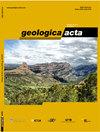Origin and evolution of Neoproterozoic metaophiolitic mantle rocks from the eastern Desert of Egypt: Implications for tectonic and metamorphic events in the Arabian-Nubian Shield
IF 2
4区 地球科学
Q2 GEOLOGY
引用次数: 0
Abstract
The mantle rocks from Kadaboura and Madara areas represent sections of dismembered ophiolitic complexes developed during the Neoproterozoic in the Eastern Desert of Egypt, which is located in the northwestern corner of the Arabian–Nubian Shield. The Kadaboura mantle rocks comprise serpentinites and serpentinized dunites, whereas those of the Madara consist of serpentinites and serpentinized pyroxenites.Despite the serpentinization of the studied mantle rocks, few relicts of primary chromite, olivine and pyroxene are preserved. Chromite is partly altered having unaltered Al-rich chromite cores surrounded by Fe-rich chromite and Cr-rich magnetite rims. The unaltered Al-rich chromite cores show compositions equilibrated at temperatures mostly below ~500-600°C, which is a temperature comparable to that estimated for primary chromite in greenschist up to lower amphibolite facies rocks. The high Cr# [100×Cr/(Cr+Al)= 47-76] of the unaltered chromite cores and the Mg-rich nature of the olivine relicts (Fo91–94) indicate that the studied mantle rocks were produced from a highly depleted mantle that experienced high degrees of melt extraction (mostly ~30-40%). This range of melt extraction resembles that estimated for supra-subduction zone peridotites, but higher than that in abyssal and passive margin peridotites. Furthermore, the clinopyroxene relicts show compositions comparable to those from the Mariana forearc peridotites. Bulk-rock geochemistry also reflects derivation from an extremely depleted and a highly refractory mantle source. Modelling of rare-earth elements suggests that the studied mantle rocks were possibly formed by the interaction of their highly depleted harzburgitic mantle precursors with subduction-related melts/fluids during their evolution in a fore-arc basin of the supra-subduction zone.The proposed geodynamic model suggests that the oceanic lithosphere generated during the seafloor spreading of the Mozambique Ocean was emplaced in the upper plate of the intra-oceanic subduction zone, in which the formely depleted Neoproterozoic mantle of the Arabian-Nubian Shield experienced mature phases of hydrous melting, extreme depletion and enrichment.埃及东部沙漠新元古代变质岩的起源和演化:对阿拉伯-努比亚地盾构造和变质事件的启示
Kadabura和Madara地区的地幔岩代表了埃及东部沙漠新元古代发育的肢解蛇绿岩杂岩的部分,该地区位于阿拉伯-努比亚地盾的西北角。Kadabura地幔岩由蛇纹岩和蛇纹石化纯岩组成,而Madara地幔岩则由蛇纹石和蛇纹化辉石岩组成。尽管所研究的地幔岩石存在蛇纹石化,但很少保留原生铬铁矿、橄榄石和辉石的残余。铬铁矿部分蚀变,具有未改变的富铝铬铁矿核心,周围为富铁铬铁矿和富铬磁铁矿边缘。未经改变的富铝铬铁矿岩芯显示,其成分在主要低于500-600°C的温度下达到平衡,这一温度与绿片岩至下角闪岩相岩石中原生铬铁矿的估计温度相当。未改变的铬铁矿岩芯的高Cr#[100×Cr/(Cr+Al)=47-76]和橄榄石残余物的富镁性质(Fo91–94)表明,所研究的地幔岩石是由经历了高度熔融提取(大部分约为30-40%)的高度贫化地幔产生的。这种熔体提取范围与超俯冲带橄榄岩的估计范围相似,但高于深海和被动边缘橄榄岩的熔体提取范围。此外,斜辉石残余物的成分与马里亚纳弧前橄榄岩的成分相当。大块岩石地球化学也反映了源自极度枯竭和高度难熔的地幔源。稀土元素的建模表明,所研究的地幔岩可能是由其高度贫化的方辉橄榄岩地幔前体在超俯冲带弧前盆地演化过程中与俯冲相关的熔体/流体相互作用形成的。所提出的地球动力学模型表明,莫桑比克洋海底扩张过程中产生的海洋岩石圈被侵位在洋内俯冲带的上板块,在该俯冲带中,阿拉伯-努比亚地盾的前贫化新元古代地幔经历了含水熔融、极端贫化和富集的成熟阶段。
本文章由计算机程序翻译,如有差异,请以英文原文为准。
求助全文
约1分钟内获得全文
求助全文
来源期刊

Geologica Acta
地学-地质学
CiteScore
2.50
自引率
6.70%
发文量
13
审稿时长
>12 weeks
期刊介绍:
- Relevant conceptual developments in any area of the Earth Sciences.
- Studies presenting regional synthesis.
- Thematic issues or monographic volumes presenting the results from one or more research groups.
- Short papers reflecting interesting results or works in progress.
- Contributions and results from Research Projects, Workshops, Symposiums, Congresses and any relevant scientific activity related to Earth Sciences.
- Geologica Acta aims to stimulate rapid diffusion of results and efficient exchange of ideas between the widespread communities of Earth Science researchers (with special emphasis on Latinamerica, the Caribbean, Europe, the Mediterranean
 求助内容:
求助内容: 应助结果提醒方式:
应助结果提醒方式:


